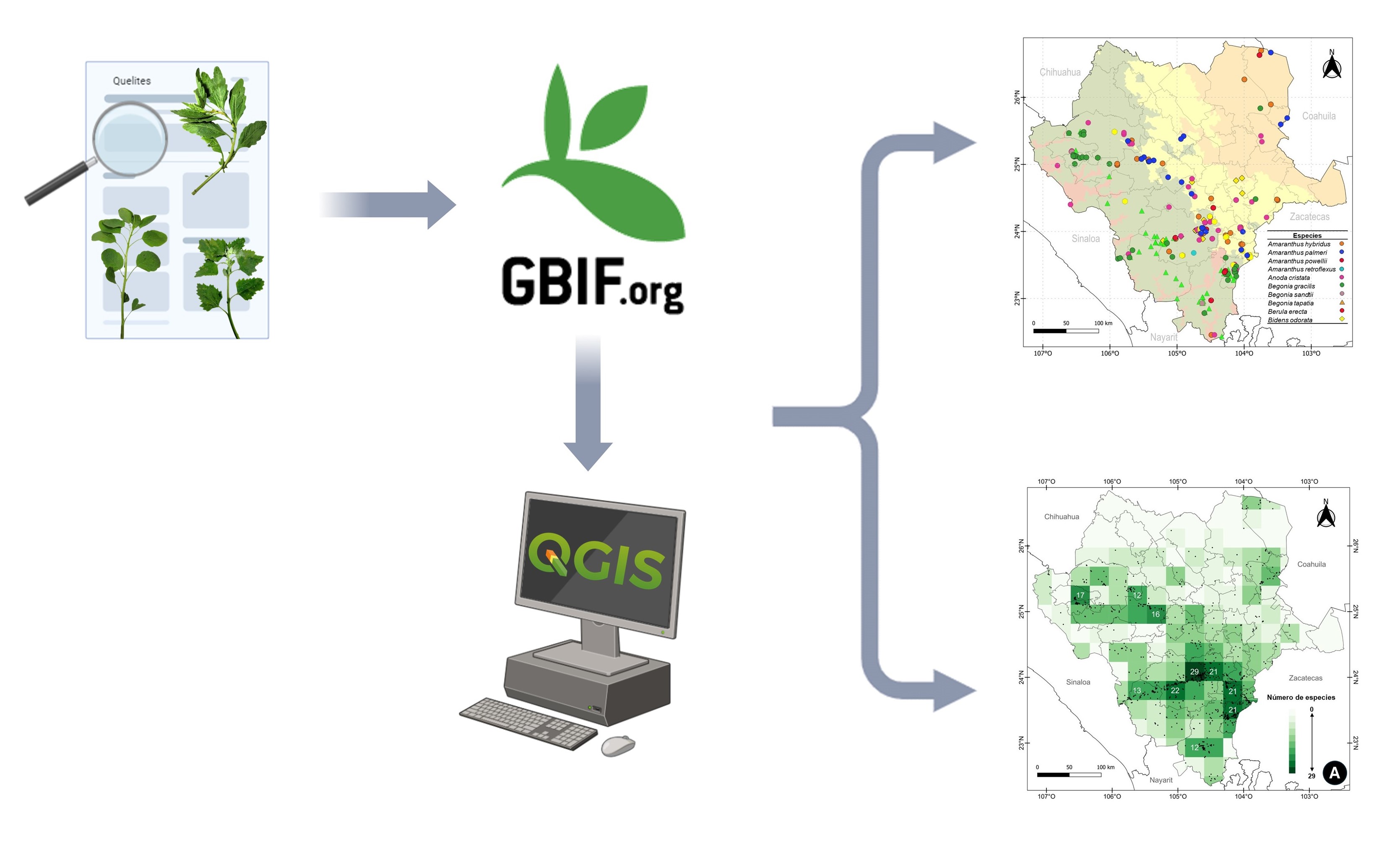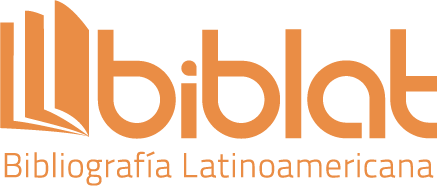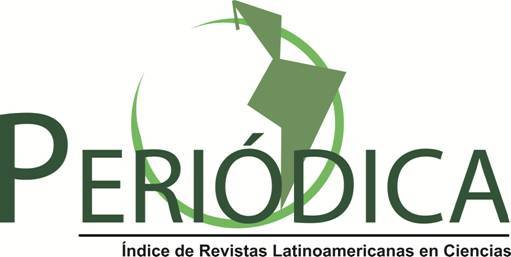Richness and distribution of quelites from Durango, Mexico: an analysis based on GBIF data
DOI:
https://doi.org/10.18633/biotecnia.v26.2379Keywords:
Quelites, Edible wild plants, DurangoAbstract
Wild plants have been an important food source for Mexicans since pre-Hispanic times. A highly nutritious group, which is representative of these plants and a valuable element of Mexican gastronomy, is that of quelites, whose leaves, stems, and flowers are consumed when tender. For some regions of Mexico, such as Durango, information about the diversity and distribution of quelite species is limited. This study aimed to analyze the current state of knowledge about the relevance of quelites in the nutrition of the population of the State of Durango, Mexico, as well as create richness and distribution maps using the Global Biodiversity Information Facility (GBIF) databases. Considering the literature and the GBIF, 39 species belonging to 15 botanical families were selected, mainly distributed throughout the Sierra Madre Occidental (SMO). Durango, Nombre de Dios, Súchil, and Vicente Guerrero were revealed as municipalities with the highest species richness. Studies such as the present one are essential to revalue quelites as highly nutritious foods, promote their cultivation and local economic development, and contribute to their conservation and sustainable use and the food security of Mexico.
Downloads
References
Aragón-Parada, J., Carrillo-Reyes, P., Rodríguez, A., y Munguía-Lino, G. 2019. Diversidad y distribución geográfica del género Sedum (Crassulaceae) en la Sierra Madre del Sur, México. Revista Mexicana de Biodiversidad 90: e902921. https://doi.org/10.22201/ib.20078706e.2019.90.2921
Arrazola-Guendulay, A. A., Hernández-Santiago, E. y Rodríguez-Ortiz, G. 2018. Conocimiento tradicional de plantas silvestres en una comunidad de los Valles Centrales de Oaxaca. Revista Mexicana de Agroecosistemas 5: 55-78.
Ávila-Uribe, M. M., García-Zárate, S. N., Sepúlveda-Barrera, A. S. y Godínez-Rodríguez, M. A. 2016. Plantas medicinales en dos poblados del municipio de San Martín de las Pirámides, Estado de México. Polibotánica 42: 215-245. https://doi.org/10.18387/polibotanica.42.11
Balcázar-Quiñones, A., White-Olascoaga, L., Chávez-Mejía, C. y Zepeda-Gómez, C. 2020. Los quelites: riqueza de especies y conocimiento tradicional en la comunidad otomí de San Pedro Arriba, Temoaya, Estado de México. Polibotánica 48: 219-242. https://doi.org10.18387/polibotanica.49.14
Basurto, P. F. 2021. Cultivo de quelites en los valles centrales de Oaxaca, México. Etnobiología 19: 89-102.
Bye, R. y Linares, E. 2023. Ethnobotany in the sierra Tarahumara, Mexico: mountains as barriers, conduits, and generators of plant-people interactions and relationships. En A. Casas y J. J. Blancas-Vázquez (eds.). pp: 129-148. Ethnobotany of the Mountain Regions of Mexico: Ethnobotany of Mountain Regions. Springer, Switzerland. https://doi.org/10.1007/978-3-319-77089-5_57-1
Bye, R., Linares, E. 2011. Continuidad y aculturación de plantas alimenticias: los quelites especies subutilizadas de México. En Especies Vegetales Poco Valoradas: Una Alternativa para la Seguridad Alimentaria. O. L. M. Mera, L. D. Castro y R. Bye. (eds.). pp: 11-22. Instituto de Biología, UNAM. México, D. F.
Carrasco-Ortiz, M., Munguía-Lino, G., Castro-Castro, A., Vargas-Amado, G., Harker, M., Rodríguez, A. 2019. Riqueza, distribución geográfica y estado de conservación del género Dahlia (Asteraceae) en México. Acta Botánica Mexicana 126: e1354. https://doi.org10.21829/abm126.2019.1354
Castro, L. D., Basurto, F., Mera, O. L. M. y Bye, R. 2011a. Los quelites, tradición milenaria en México. Universidad Autónoma de Chapingo. Texcoco, Estado de México.
Castro, L. D., Bye, R. y Mera, O. L. M. 2011b. Diagnóstico del pápaloquelite en México, Porophyllum ruderale (Jacq.) Cass. var. macrocephalum (DC.) Cronq. Universidad Autónoma Chapingo. Texcoco, Estado de México.
Cedano-Maldonado, M., Villaseñor-Ibarra, L., Haro-Luna., M. X. 2023. Wixaritari or Huichol ethnobotany of the southern Sierra Madre Occidental in Mexico. En A. Casas y J. J. Blancas-Vázquez (eds.). pp: 197-231. Ethnobotany of the Mountain Regions of Mexico: Ethnobotany of Mountain Regions. Springer, Switzerland. https://doi.org/10.1007/978-3-319-77089-5_57-1
Chávez-Hernández, M. G. y Alvarado-Cárdenas, L. O. 2022. Taxonomía, distribución y conservación de Funastrum (Apocynaceae; Asclepiadoideae) en México. Botanical Sciences 100: 1073-1101. https://doi.org/10.17129/botsci.3018
De Melo, P. H. A., Bystriakova, N., Lucas, E. y Monro, A. K. 2024. A new R package to parse plant species occurrence records into unique collection events efficiently reduces data redundancy. Scientific Reports, 14, 5450. https://doi.org/10.1038/s41598-024-56158-3
Del Rio, N. D., Santana, N., Peláez-Ballestas, I., González-Chávez, S. A., Quiñonez-Flores, C. M. y Pacheco-Tena, C. 2016. Prevalence of rheumatic diseases in Raramuri people in Chihuahua, Mexico: a community-based study. Clinical Rheumatology 35: 43-52. https://doi.org/10.1007/s10067-016-3225-x
Flores-Sánchez, D., Hernández-Ruíz, A., Navarro-Garza, H., Vázquez-García, V. y Vibrans, H. 2022. Plantas silvestres en la alimentación de familias campesinas en Tecoanapa, Guerrero. Agricultura, Sociedad y Desarrollo 19: 154-167. https://doi.org10.22231/asyd.v19i2.1289
GBIF Secretariat. 2023. GBIF Science Review Nº 10. https://doi.org/10.35035/37pp-tt84
GBIF. 2024a. ¿Qué es GBIF? Disponible en: https://www.gbif.org/what-is-gbif [Consultado:11-04-2024].
GBIF. 2024b. GBIF Occurrence Download. Disponible en: https://www.gbif.org/ [Consultado:15-01-2024].
González-Elizondo, M. S., González-Elizondo, M., Márquez-Linares, M. A. 2007. Vegetación y ecorregiones de Durango. Plaza y Valdés Editores-Instituto Politécnico Nacional. México, D.F.
González-Elizondo, M. S., González-Elizondo, M., Tena-Flores, J. A., Ruacho-González, L. y López-Enríquez, I. L. 2012. Vegetación de la Sierra Madre Occidental, México: Una síntesis. Acta Botánica Mexicana 100: 351-403. https://doi.org/10.21829/abm100.2012.40
González-Elizondo, M., González-Elizondo, M. S., López-Enríquez, I. L., y Herrera-Arrieta, Y. 2017. Importancia económica y usos tradicionales de la flora. En A. Cruz-Angón, E. Castaños-Rochell, J. Valero-Padilla y E. Melgarejo (Coords.). pp. 533-528. La biodiversidad en Durango. Estudio de Estado. Comisión Nacional para el Conocimiento y Uso de la Biodiversidad. México.
González-Elizondo, M., López-Enríquez, I. L., González-Elizondo, M. S., Tena-Flores, J. A. 2004. Plantas Medicinales del Estado de Durango y Zonas Aledañas. Instituto Politécnico Nacional. México, DF.
González-Gallegos, J. G., Castro-Castro, A., González-Elizondo, M., López-Enríquez, I. L., Ruacho-González, L. y Retana-Rentería, F.I. 2022. Riqueza y distribución de Lamiaceae en el estado de Durango, México. Revista Mexicana de Biodiversidad 93: e933838. https://doi.org/10.22201/ib.20078706e.2022.93.3838
González-Jácome, A. y Reyes-Montes, L. 2014. El conocimiento agrícola tradicional, la milpa y la alimentación: el caso del Valle de Ixtlahuaca, Estado de México. Revista de Geografía Agrícola 52-53: 21-42.
Guadarrama-Martínez, N., Rubí-Arriaga, M., Chávez-Mejía, M. C. y Thomé-Ortiz, H. 2022. Usos antrópicos de las plantas vasculares en el sureste del Estado de México. Península 17: 175-202.|
Gutiérrez-Velázquez, M. V., Almaraz-Abarca, N., Ávila-Reyes, J. A., Delgado-Alvarado, E. A., González-Valdez, L. S., Torres-Ricario, R., Monreal-García, H. M. y Vasavilbazo-Saucedo, A. 2024. Effect of salinity on DNA methylation and antioxidant phenolic compounds of wild watercress (Rorippa nasturtium aquaticum). Plant Science Today 11: 196-205. https://doi.org/10.14719/pst.2577
Gutiérrez-Velázquez, M.V., Almaraz-Abarca, N., Herrera-Arrieta, Y., Ávila-Reyes, J.A., González-Valdez, L. S., Torres-Ricario, R., Uribe-Soto, J. N. y Monreal-García, H. M. 2018. Comparison of the phenolic contents and epigenetic and genetic variability of wild and cultivated watercress (Rorippa nasturtium var. aquaticum L.). Electronic Journal of Biotechnology 34: 9-16. https://doi.org10.1016/j.ejbt.2018.04.005
Linares, E. y Bye, R. 2015. Las especies subutilizadas de la milpa. Revista Digital Universitaria 16: 1-22.
Linares, E., Bye, R., Ortega, N. y Arce AE. 2017. Quelites: sabores y saberes del sureste del Estado de México. Universidad Nacional Autónoma de México. Ciudad de México. https://doi.org 10.22201/ib.9786073016667e.2019
Luo, M., Xu, Z., Hirsch, T., Aung, T. S., Xu, W., Ji, L., Qin, H. y Ma, K. 2021. The use of Global Biodiversity Information Facility (GBIF)-mediated data in publications written in Chinese. Global Ecology and Conservation 25: e01406. https://doi.org/10.1016/j.gecco.2020.e01406
Manzanero-Medina, G. I., Vásquez-Dávila, M. A., Lustre-Sánchez, H. y Pérez-Herrera, A. 2020. Ethnobotany of food plants (quelites) sold in two traditional markets of Oaxaca, Mexico. South African Journal of Botany 130: 215-223. https://doi.org/10.1016/j.sajb.2020.01.002
Mapes, C. y Basurto, F. 2016. Biodiversity and edible plants of Mexico. En R. Lira, A. Casas y J. Blancas (Eds.). Ethnobotany of Mexico, interactions of people and plants in Mesoamerica. Springer, New York, USA. https://doi.org/10.1007/978-1-4614-6669-7
Martínez, M. Á., Evangelista, V., Basurto, F., Mendoza, M. y Cruz-Rivas, A. 2007. Flora útil de los cafetales en la Sierra Norte de Puebla, México. Revista Mexicana de Biodiversidad 78:15-40.
Martínez, P. S. S.,, Aguilar-Galván, F. y Hernández-Sandoval, L. 2021. Plantas silvestres comestibles de la Barreta, Querétaro, México y su papel en la cultura alimentaria local. Revista Etnobiología 19: 41-62.
Mateos-Maces, L., Chávez-Servia, J. L., Vera-Guzmán, A. M., Aquino-Bolaños, E. N., Alba-Jiménez, J. E. y Villagómez-González, B.B. 2020. Edible leafy plants from Mexico as sources of antioxidant compounds, and their nutritional, nutraceutical and antimicrobial potential: A review. Antioxidants 9: 541. https://doi.org10.3390/antiox9060541
Medrano-Guerrero, A., Carranza, E., Juárez-Vázquez, M. D. C., Solano, E., Ruiz-Padilla, A. J., Ruiz-Noa, Y., Deveze-Alvarez, M. A., Brennan-Bourdon, L. M. y Alonso-Castro, A. J. 2023. Medicinal plants used in rural communities from the municipality of Dolores Hidalgo, Guanajuato, Mexico. Boletín Latinoamericano y del Caribe de Plantas Medicinales y Aromáticas 22: 524-536. https://doi.org10.37360/blacpma.23.22.4.39
Morales-Valenzuela, G., Hernández-López, D. M. y Padilla-Vega, J. 2022. Diversity, abundance, and uses of vegetables in milpas within a Tsotsil community of Huitiupán, Chiapas. Revista Chapingo Serie Agricultura Tropical 2: 5-16. https://doi.org10.5154/r.rchsagt.2021.03.01
Narváez-Elizondo, R. E. 2020. Las plantas silvestres también se comen: un patrimonio biocultural por rescatar. Árido-Ciencia 5: 2-21.
Narváez-Elizondo, R. E., González-Elizondo, M., González-Elizondo, M. S., Tena-Flores, J. A. y Castro-Castro A. 2020. Edible ethnoflora of the southern tepehuans of Durango, Mexico. Polibotánica 50: 245-277. https://doi.org10.18387/polibotanica.50.15
Pacheco-Hernández, Y., Lozoya-Gloria, E., Becerra-Martínez, E. y Villa-Ruano, N. 2022. Nutraceutical potential of seven “quelites” harvested in the northern highlands of Puebla-México. Horticulturae 9: 2-17. https://doi.org10.3390/horticulturae9010018
Pascual-Mendoza, S., Saynes-Vásquez, A., Pérez-Herrera, A., Meneses, M. E., Coutiño-Hernández, D. y Sánchez-Medina, M. A. 2023. Nutritional composition and bioactive compounds of quelites consumed by indigenous communities in the Municipality of Juquila Vijanos, sierra norte of Oaxaca, Mexico. Plant Foods for Human Nutrition 78: 193-200. https://doi.org/10.1007/s11130-022-01039-1
QGIS Development Team. 2023. QGIS Geographic Information System. Open Source Geospatial Foundation Project. http:// qgis. osgeo.org
Román-Cortés, N.R., García-Mateos, M. D. R., Castillo-González, A. M., Sahagún-Castellanos, J. y Jiménez-Arellanes, M. A. 2018. Características nutricionales y nutracéuticas de hortalizas de uso ancestral en México. Revista Fitotecnia Mexicana 41: 245-25. https://doi.org10.35196/rfm.2018.3.245-253
Sandoval-Ortega, M. H., De Loera-Ávila, E. E. D., Martínez-Calderón, V. M. y Zumaya-Mendoza, S. G. 2023. Plantas silvestres comestibles del estado de Aguascalientes, México, sus formas de consumo y comercialización. Polibotánica 55: 213-230. https://doi.org10.18387/polibotanica.55.14
Santiago-Saenz, Y. O., Hernández-Fuentes, A. D., López-Palestina, C. U., Garrido-Cauich, J. H., Alatorre-Cruz, J. M. y Monroy-Torres, R. 2019. Importancia nutricional y actividad biológica de los compuestos bioactivos de quelites consumidos en México. Revista Chilena de Nutrición 46: 593-605. https://doi.org10.4067/S0717-75182019000500593
Servicio de Información Agroalimentaria y Pesquera (SIAP). 2023. Panorama de la frontera agrícola de México por Representación Estatal SADER 2022. Disponible en: https://www.gob.mx/siap/documentos/panorama-de-la-frontera-agricola-de-mexico-por-representacion-estatal-sader-295448 [Consultado: 30-05-2024].
Valenzuela-Núñez, L. M. y Briceño-Contreras EA. 2017. Uso de hongos, flora y fauna silvestre. En A. Cruz-Angón, E. Castaños-Rochell, J. Valero-Padilla y E. Melgarejo (Coords.). pp. 503-507. La biodiversidad en Durango. Estudio de Estado. Comisión Nacional para el Conocimiento y Uso de la Biodiversidad. México.
Viesca-González, F. C., Alvarado-Carrillo, D. D. J. y Quintero-Salazar, B. 2022. Los quelites en la ciudad de Toluca, México: su recolección, comercialización y consumo. Estudios sociales. Revista de Alimentación Contemporánea y Desarrollo Regional 32: e221158. https://doi.org10.24836/es.v32i59.1158
Villaseñor, J. L. 2016. Checklist of the native vascular plants of Mexico. Revista Mexicana de Biodiversidad 87: 559-902. https://doi.org10.1016/j.rmb.2016.06.017
Villaseñor, J. L., Ortiz, E. y Sánchez-González A. 2022. Riqueza y distribución de la flora vascular del estado de Hidalgo, México. Revista Mexicana de Biodiversidad 93: e933920. https://doi.org10.22201/ib.20078706e.2022.93.3920

Downloads
Published
How to Cite
Issue
Section
License
Copyright (c) 2023

This work is licensed under a Creative Commons Attribution-NonCommercial-ShareAlike 4.0 International License.
The journal Biotecnia is licensed under the Attribution-NonCommercial-ShareAlike 4.0 International (CC BY-NC-SA 4.0) license.




_(1)_(1).png)






_(2).jpg)





